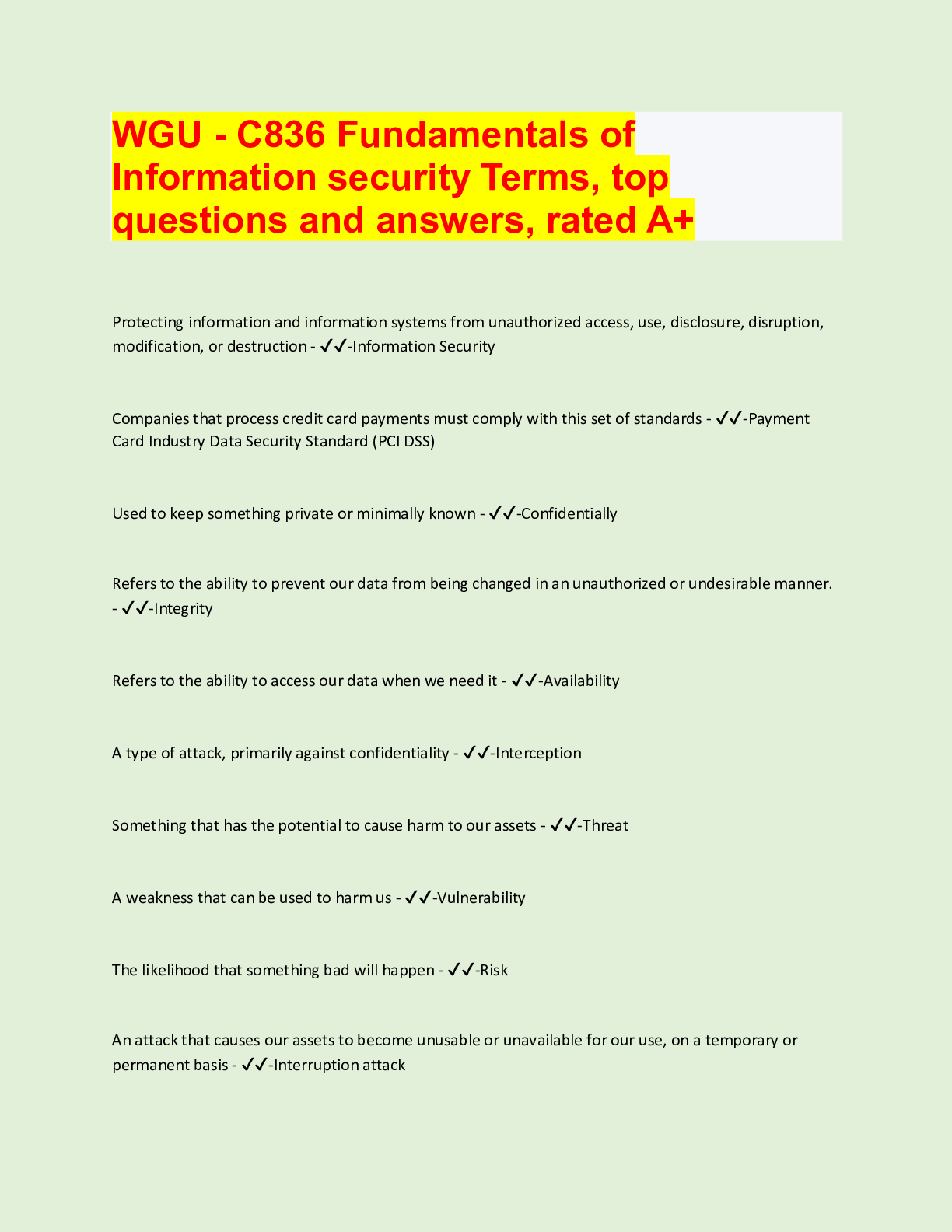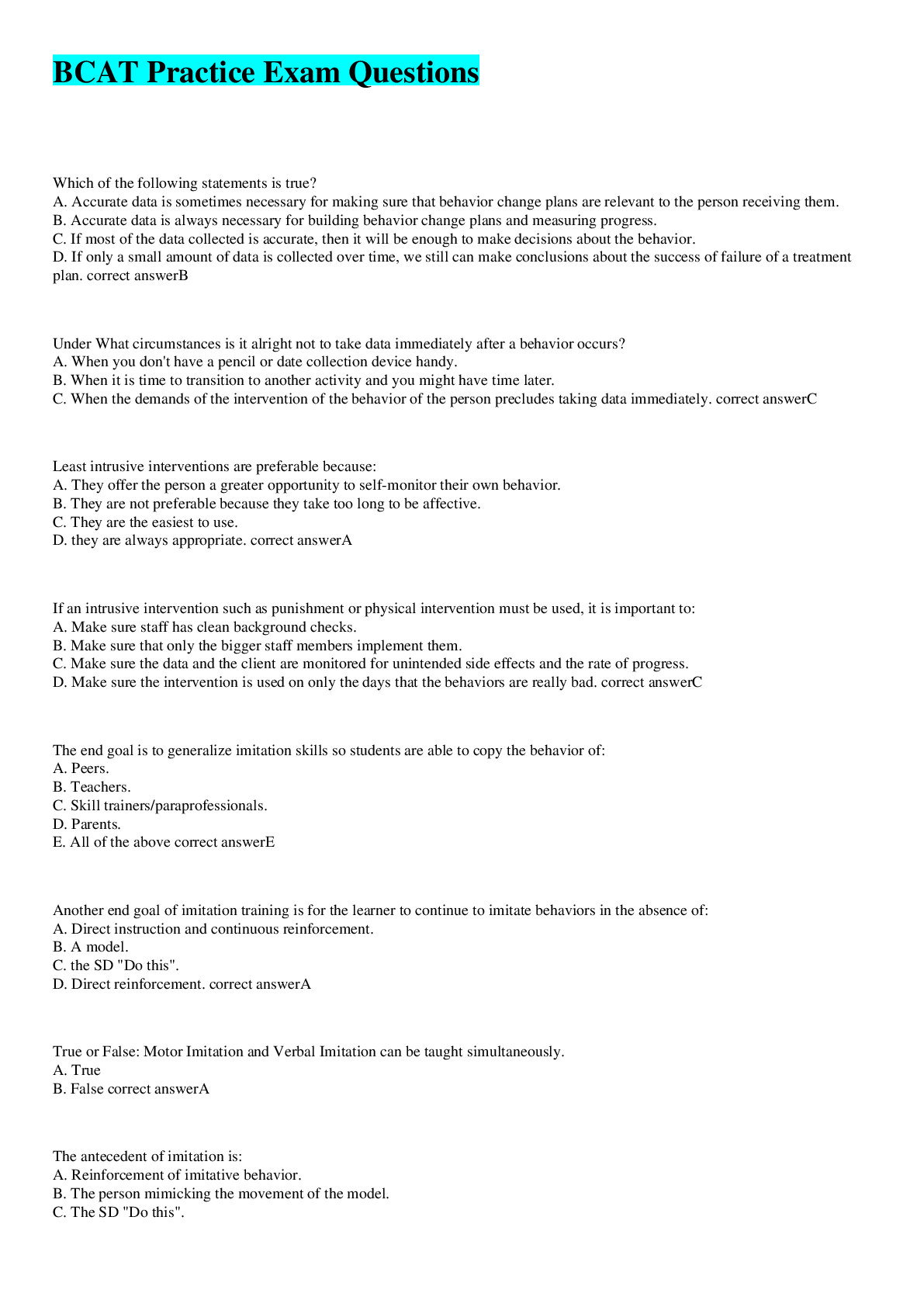Education > QUESTIONS & ANSWERS > WGU- Educational Assessment EXAM 2022 (All)
WGU- Educational Assessment EXAM 2022
Document Content and Description Below
General Responsibilities of Ethical Practices 1. Protect the health and safety of all participants 2. Be knowledgeable about and behave in compliance with state and federal laws relevant to the cond... uct of professional activities 3. Maintain and improve their professional competence in educational assessment 4. Provide assessment services only in areas of their competence and experience, affording full disclosure of their professional qualifications 5. Promote the understanding of sound assessment practices in educations 6. Adhere to the highest standards of conduct and promote professionally responsible conduct with educational institutions and agencies that provide educational services 7. Perform all professional responsibilities with honesty, integrity, due care, and fairness. No Child Left Behind (NCLB) 2002 is a government mandate to schools and states to have ALL children up to grade level with their peers. It set unrealistic goals and penalized schools that did not make Adequate Yearly Progress (AYP). The act also required all teachers become "highly qualified". With these new benchmarks and changes to the ways states' addressed education, came increased accountability. Failure could mean a decrease in funding or dissolution of a school/district. Achievement was linked to standardized testing done grades 3-8 and at least one year during high school. Tied achievement to annual standardized tests. These tests are administered to grades 3-8 and at least one year between 9-12th grades. 00:02 01:10 Elementary and Secondary Education Act 1994 (ESEA). Reauthorized Challenging standards were set for student achievement and to develop and administered to "all" students and required that all schools make "Adequate Yearly Practice". It also included "special needs students" in the definition of all students. States were required to set challenging standards for student achievement, and develop and administer assessments to measure student progress towards those standards. Federal laws such as ESEA and IDEA can be seen as legislated attempts to 'raise the bar.' Instruction is most effective when 1. Directed toward a clearly defined set of intended learning outcomes. 2. The methods and materials of instruction are congruent with the outcomes to be achieved. 3. The instruction is designed to fit the characteristics and needs of the students. 4. Instructional decisions are based on information that is meaningful, dependable, and relevant. 5. Students are periodically informed concerning their learning progress. 6. Remediation is provided for students not achieving the intended learning. 7. Instructional effectiveness is periodically reviewed and the intended learning outcomes and instruction modified as needed. Assessment is most effective when 1. Designed to assess a clearly defined set of intended learning outcomes. 2. The nature and function of the assessments are congruent with the outcomes to be assessed. 3. The assessments are designed to fit the relevant student characteristics and are fair to everyone. 4. Assessments provide information that is meaningful, dependable, and relevant. 5. Provision is made for giving the students early feedback of assessment results. 6. Specific learning weaknesses are revealed by the assessment results. 7. Assessment results provide information useful for evaluating the appropriateness of the objectives, the methods, and the materials of instruction. Authentic Assessments A title for performance assessments that stresses the importance of focusing on the application of understandings and skills to real problems in real-world; contextual settings. Achievement Assessment achievement assessment is a broad category that includes all of the various methods for determining the extent to which students are achieving the intended learning outcomes of instruction Alternative Assessments A title for performance assessments that emphasizes that these assessment methods provide an alternative to traditional paper-and-pencil testing. Content standards describe what students should know and be able to do at the end of a specified period of learning (e.g., a grade or series of grades). They provide a framework for curriculum development, instruction, and the assessment of student achievement. Various professional organizations have also developed sets of content standards in their particular subject areas. It is hoped that the use of such standards will raise achievement expectations, increase the quality of public education, provide a better informed citizenship, and make the country more competitive with other countries. [Show More]
Last updated: 2 years ago
Preview 1 out of 11 pages

Buy this document to get the full access instantly
Instant Download Access after purchase
Buy NowInstant download
We Accept:

Reviews( 0 )
$7.00
Can't find what you want? Try our AI powered Search
Document information
Connected school, study & course
About the document
Uploaded On
Aug 24, 2022
Number of pages
11
Written in
Additional information
This document has been written for:
Uploaded
Aug 24, 2022
Downloads
0
Views
85








.png)

.png)





